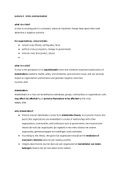Lecture 2 - Crisis communication
what is a crisis?
A crisis is a turning point in a situation, where an important change takes place that could
determine a negative outcome.
For organizations, crises include:
● natural crises (floods, earthquakes, fires)
● political crises (corruption, changes in government)
● internal crises (misconduct, abuse)
● ...
what is a crisis?
A crisis is the perception of an unpredictable event that threatens important expectations of
stakeholders related to health, safety, environmental, and economic issues, and can seriously
impact an organization’s performance and generate negative outcomes.
Coombs, 2015
stakeholders
Stakeholders in a crisis can be defined as individuals, groups, communities or organizations, who
may affect, be affected by or perceive themselves to be affected by the crisis.
Ndlela, 2019
why stakeholders?
● Interest around stakeholders comes from stakeholder theory, an economic theory that
posits that organizations are embedded in a series of relationships with other
organizations, communities, and institutions such as governments. een economische
theorie die stelt dat organisaties zijn ingebed in een reeks relaties met andere
organisaties, gemeenschappen en instellingen zoals overheden.
● According to this theory, the goal of an organization should be the mediation of
everyone’s interests (and not just making a profit).
● Volgens deze theorie zou het doel van een organisatie het bemiddelen van ieders
belangen moeten zijn (en niet alleen winst maken).
, ● “an organization’s success is dependent on how well it manages the relationships with
key groups such as customers, employees, suppliers, communities, financiers and others
that can affect the realization of its purpose (en anderen die de realisatie van het doel
ervan kunnen beïnvloeden)” (R. Edward Freeman & Phillips, 2002).
You are a company called Nabisco, you close down the factory in the US and open in Mexico
where you can pay employees less, but they go on strike and that goes on social media and
people see that and stop buying your products. One group of stakeholders can have a spillover
effect on other groups.
Stakeholder classification: why and how?
organizations as networks
Most organizations, no matter if NGO or commercial, are
involved in a number of relationships that include people
inside and outside of the organization. When thinking of how
to respond to a crisis, organizations should understand:
● which stakeholders are affected
● how seriously they are affected
● what are the consequences of the stakeholders being
affected > you might pay different attention to the
different groups
● …this requires a classification.
,Figuring out how you react to different stakeholders is called: stakeholder management
It is not to prevent a crisis but make sure the moment a crisis hits, you are ready.
At the center of establishing (aangaan) and maintaining relationships with stakeholders: is
communication. Organizations should:
● Be aware of whom to relate to in case of a crisis (weet met wie u contact kunt opnemen
in geval van een crisis)
● Involve stakeholders in pre-crisis preparedness, for crises that can be prevented
● Establish appropriate communication channels for each stakeholder (zorg voor
passende communicatiekanalen voor elke belanghebbende)
4 phases of stakeholder management
, stakeholder management
Two fundamental questions:
1. How to define and identify stakeholders?
2. How to manage the relationship with various stakeholder groups?
Classifying stakeholders in 3 ways:
primary vs secondary stakeholder
Primary stakeholders: those who are directly, significantly or potentially affected by the
activities of the organization (employees, customers, suppliers, etc). This can also mean those
who are directly, significantly and potentially affected by a crisis.
Secondary stakeholders: those indirectly affected or for whom the impact is not that direct,
such as the media, special interest groups and authorities (same as diffusive stakeholders)
internal vs external stakeholder
Internal stakeholders: directly affected and take part in the organization’s decision-making and
operations. E.g. managers, owners, employees
External stakeholders: not involved in the organization’s operations. E.g. customers, suppliers,
authorities
organizational linkage
What can stakeholders do for us? For our organisation?





